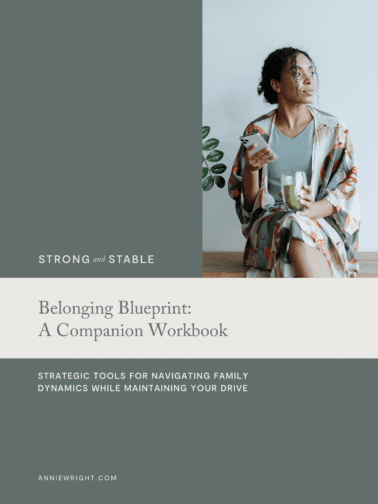Today is Halloween – one of my very favorite holidays.
I’ve always loved Halloween – as a kid and teen, it was fun to dress up and certainly to collect a pillowcase full of KitKats.
Then as a young adult, Halloween parties with costumed friends were always a highlight.
Now as a parent of a toddler, there’s nothing more fun than seeing my kid ridiculously excited because she gets to be a panda for an evening (plus I love seeing my friends’ children in their super sweet costumes all over Instagram).
And since becoming a therapist, I’ve always appreciated Halloween for the way it allows for something I think that’s so important to relational trauma recovery – parts work: letting ourselves try on different “parts” for a night.
What do I mean by this?
Halloween is a very distinct and discrete time of the year when it’s “socially acceptable” for us to bring out one of the many “parts” inside of us by stepping into a costume, a guise, another persona.
Halloween is a time when we’re “allowed” to step into a character that’s probably unlike anything we typically embody in the other 364 days of our year – the witch, the superhero, the seductress, the destructive and evil “bad guy.”
No matter how elaborately or what you dress up as, Halloween allows us an appropriate and safe outlet for creativity, self-expression, and spontaneity — psychologically healthy impulses.
It also allows us to give space and voice to aspects of ourselves that perhaps don’t get a chance to be conscious in other realms of our lives.
Which, in essence, is akin to the therapy tool of “parts work” – an integral part of relational trauma recovery work.
If you’re curious about parts work and what the psychological benefit is when we get to know and then re-integrate disowned and disavowed parts of ourselves again, please read on.
What is Parts Work?
Parts Work – specifically getting to know the disowned and disavowed parts of us and then actively working to reclaim and integrate them into our conscious adult lives – is a critical skill we build in relational trauma recovery work.
But what exactly is Parts Work?
Parts Work is a way of thinking that has roots and genesis in many schools of thought: Gestalt Therapy, Internal Family Systems, Voice Dialogue, and even Jungian Archetypal work.
While each school of thought has its own methodology, Parts Work, as I define it and use it in my therapy room and in my online courses, is a therapeutic lens that assumes that each of us has many different parts to our minds and psyches.
Each of these parts (or subpersonalities) has unique needs, wants, and beliefs and may be conscious or unconsciously playing out helping or harming us as we move through our days encountering different situations, triggers, and scenarios.
What's Running Your Life?
The invisible patterns you can’t outwork…
Your LinkedIn profile tells one story. Your 3 AM thoughts tell another. If vacation makes you anxious, if praise feels hollow, if you’re planning your next move before finishing the current one—you’re not alone. And you’re *not* broken.
This quiz reveals the invisible patterns from childhood that keep you running. Why enough is never enough. Why success doesn’t equal satisfaction. Why rest feels like risk.
Five minutes to understand what’s really underneath that exhausting, constant drive.
By bringing our awareness to these many different parts within us – giving each part a voice, learning what each part needs, wants, and fears and understanding when, how and why each part gets triggered – we are then more able to lovingly integrate (not eliminate!) the many aspects within us to create more choice, expand our capacity to creatively problem solve, and to give us a greater sense of wholeness and aliveness in our daily lives.
What is an example of a disowned and disavowed part?
Examples of disowned and disavowed parts are as multitudinous as there are people on the planet.
But here are a few examples to illustrate what this might subjectively look like for some people:
As an example, let’s imagine a young woman.
Who put aside the soulful spiritual part of her that believes in earth-based spirituality, intuition, and psychic abilities because, growing up, she didn’t live in a family system where it was psychologically and emotionally safe enough to own that part, for her family to see that those topics were important to her. Instead, this girl learned it was psychologically and emotionally safer to be smart and accomplished, so she poured all of her energy and time into academics to belong, to fit in, and to keep herself safe, disowning those soul-centered desires of hers and relegating those interests to “childish fantasies.” She disavowed the spiritual, soulful, intuitive, and mystical side of her.
As another example, let’s imagine a young boy.
Who loved musicals and theatre and the color purple but who was teased by peers and his family for being “effeminate” for liking those things, and so this young boy, learning it wasn’t “safe” to allow himself to love what he loved, compensated by throwing through himself into sports (a pursuit acceptable to his family and peers), though sports and competition didn’t feed his soul. He disavowed the creative, performative, entertainer side of him.
And finally, let’s imagine a woman.
Who grew up steeped in the Purity Culture of evangelical Christianity and didn’t allow herself to experiment with her sexuality and partner preferences as she came of age as a teen because it would have been “wrong to do so.” Let’s imagine that this young woman, fearing retribution from her family and church community instead “did what she was supposed to do” and married young in a “socially acceptable” heteronormative construct, and didn’t have sex before marriage. She disavowed the sexually fluid, sexually curious, sexually dynamic part of herself.
Again, these examples are just the tip of the iceberg. There are a million other ways that we grow up in our families, communities, and this culture and come to disown and disavow parts of ourselves.
How do we identify and re-integrate the disowned parts of ourselves?
Again, when we can identify and “reclaim” the lost, disowned or disavowed parts of us, it can create more vitality and enlivenment in our days. This is a key skill that we want to build in relational trauma recovery work to help create the most beautiful adulthood for ourselves despite adverse early beginnings.
So how do we actually re-claim and re-integrate those parts of ourselves?
First, we get curious about what we know – even a little bit – that we may have disowned in ourselves. To do this, consider:
What do I have strong, knee-jerk reactions to? What engenders really strong reactions in me?
For instance, when you see a post on Instagram of your friend who is self-employed and working from her laptop in Greece, do you feel flashes of anger and think, “She’s probably going to be penniless and you can’t start a family living a nomadic life.” In this example, such strong reactions might be a clue that this – living abroad and creatively – is the very thing you hunger for but don’t let yourself own and embrace about yourself. Do you have a nomadic, international traveler part of you that’s been disowned?
Ask yourself: what do you loathe or dislike in others?
For example, do you look at your significant other/spouse and have contempt for what you perceive as a weakness when they show it? In this case, for example, projection – taking the qualities you find unacceptable in yourself and attributing it to others – might be at play and might provide clues for you about what you yourself have disowned. Do you have a young, less capable, more needy part of you that you feel contempt and anger for?
What do you hunger for and find yourself drawn to but won’t really let yourself have?
For example, do you find yourself forcing yourself to browse in the “business building” and “personal growth” section of the bookstore versus the “romance or poetry sections” because you think all reading and leisure time should be productive and meaningful? Do you have a part of you that’s starved for ease, nourishment and plain old fun?
What did you love and enjoy at ages 6, 8, 10, and 12-years old?
Be curious: what did you get lost in at those ages? What did you long to be and do at those developmental stages? Your past hungers may have present clues about what parts of you have been disowned or disavowed.
Next, after getting more clear about what parts of us may have been disowned, disavowed, or relegated to minor roles in our life, we then make gentle and consistent movements back towards those parts.
For example, this might look like:
- Admitting to yourself that you yourself deeply wish you could live a more global and less tethered life. Setting your desktop wallpaper as scenes Greek islands, looking up how many Chase Ultimate rewards points you have and playing around to see if you could even get a flight to Greece, googling an article about what it would be like to have a location-independent business or side hustle, downloading podcasts of folks who live nomadic lives while raising small children.
- After seeing more clearly that the perceived weakness you see in your spouse enrages you, allowing yourself to be vulnerable the next time you truly feel that way. Maybe that looks like admitting you’re overwhelmed and struggling. Maybe that looks like seeking out a therapist. Maybe that looks like letting yourself cry when you next really want to cry.
- With more awareness of how you’re forcing yourself to “always be productive” perhaps you will order a copy of the poetry compendium you feel authentically drawn to. And keep it on your bedside table (along with the time management book you feel you “must” read, too). Maybe this looks like you using your next Audible credit on a historical romance. And actually letting yourself listen to that the next time you’re driving to pick up your kids from school. Versus catching up on work Voxers.
- Or, after identifying that building was always your favorite theme of play between the ages of 6-12 (building with legos, building make-believe worlds in the kitchen pantry. With cans and bottles. Building and making your Barbies dresses. Maybe you purchase a set of Magnatiles for yourself to play and fiddle with. Maybe you take up a hobby that channels that core theme of building. Such as home renovations. You take slow, gentle, deliberate action.
Wrapping up.
These examples are just the tip of the iceberg. About what it may mean to get curious about what parts you’ve disowned and disavowed in yourself. And how you might begin to make movements to re-integrating and reclaim these parts of yourself back into your life.
And again, the end goal is to create the most beautiful adulthood possible for ourselves after adverse early beginnings.
Do this work to recognize and reclaim those disowned and disavowed parts. Pay attention to how much more (if at all) vital and enlivened you feel as you do this.
And keep moving towards what makes you feel vital and enlivened, again and again.
Now I’d love to hear from you in the comments below:
What’s one way that you got in touch with and reclaimed a disowned part of yourself? What has the impact been since you re-integrated this part of yourself back into your life?
If you feel so inclined, please leave a comment below. Our community of 20,000+ blog readers can benefit from your wisdom.
Here’s to healing relational trauma and creating thriving lives on solid foundations.
Warmly,
Annie
Further reading if you’re curious about parts work and reclaiming parts of yourself:
- If you’ve ever been told you’re too much, read this.
- For more information on Voice Dialogue work: Embracing Ourselves: The Voice Dialogue Manual by Drs Hal and Sidra Stone.*
* This is an affiliate link and any purchases made through this link will result in a small commission for me. (at no extra cost for you)





